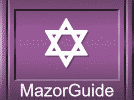|
• The Processional Music
• The Wedding Party
•
Unterfehren – Guiding the Bride and Groom Down the Aisle
• Candles
• Circling the Groom
• Where to Stand Under the Chuppah
• Roles for Children
• Remembering Departed Parents
• Gifts Under the Chuppah
Music
Each step toward the Chuppah is accompanied by music. Just as the Levites sang and played instruments as the kohen priests performed their holy duties in the Beit Hamikdash, the ancient Temple in Jerusalem. Music that amplifies this sanctity uplifts the ceremony.
Choose processional music that the evokes not only the love for your betrothed,
but music that is spiritually uplifting.
The Wedding Party
Before the bride enters, the rest of the wedding party marches down the aisle. Wedding parties originated as friendly bodyguards. A bride was escorted by family and friends so none – not even mischievous spirits - could keep her from reaching the Chuppah. Appearing with a entourage is a mark of a Very Important Person. Jewish tradition likens the bride and groom to royalty. This may be one of the reasons why bridesmaids and groomsmen have proliferated.
A biblical account of Samson’s marriage to Delilah mentions 30 men who made up the wedding party. The Hebrew term for them is shoshvinim. Since these men are only mentioned as partaking in the wedding feast, it may be more accurate to think of them as special guests rather than modern day best men.
Wedding parties fill a social role. Bridesmaids host bridal showers, buy ugly bridesmaid dresses and warm cold feet. Groomsmen do much the same, except they purchase tacky cummerbunds. The roles of a bridesmaid, best man, flower girl, ring bearer or anything else the glossy wedding magazines have dreamed up are purely for the comfort and pleasure of the newlyweds and fulfill no religious role.
Unterfehren – Guiding the Bride and Groom Down the Aisle
We are never alone. In birth, brit, marriage and death, supporting hands of love are called for and given Jewish significance. At a wedding, the unterfehren who walk down the aisle with the bride and groom stand in for the angels were present as Adam married Eve and the angels who flew thick around Mt. Sinai.
Who escorts a bride or groom down the aisle? Jewish customs vary. In some communities, parents linked arms with their child, while other traditions had the mother and mother-in-law surround the bride and the father and father-in-law hold onto the groom. Today, some couples feel more comfortable having good friends or other close relatives walk them down the aisle. Being escorted by a successful married couple, (first marriage for both) is
viewed as a good omen in some circles.
Unterfehren served a practical purpose. In the past, and still nowadays
in some circles, brides were veiled with heavy, opaque cloth. Without the unterfehren’s steadying presence, a bride would be unable to find the Chuppah.
Candles
Lit candles are carried by the unterfehren, who guide the bride and groom, as they approach the Chuppah. In Jeremiah light and marriage are linked as chief joys: “…the voice of gladness, the voice of the bridegroom, the voice of the bride… the light of the lamp.” (Jeremiah 25:10)
Beginning in the first century, bridesmaids carried lit torches, whose light
symbolized purity. The groom’s side began lighting the groom’s way by
candlelight soon afterward. According to other interpretations, candles recall
the streaks of lightning that pierced the skies over Mt. Sinai when the Torah
was received. (Exodus 19:16) Many commentators liken the giving of the Torah to
a wedding between God and the Jewish People.
Light is identified with joy. “The Jews had light, and gladness, and joy, and honor.” (Esther 8:16) Candles are a prayer that the couple will find happiness together.
Braided havdalah candles, traditionally lit at the end of Shabbat, are made of many intertwined wicks that flicker like these lightning flashes.
Single candles are often used as well. Ensconce in the candles in hurricane glasses so they don’t blow out or dribble hot wax onto hands and dresses.
Circling
Once the bride reaches the Chuppah, she circles her groom a number of times. Depending on a family’s custom, the bride would be accompanied by her parents, her mother and mother-in-law, or her entire wedding party.
Some view the circling as a measure to ward against demonic forces. One who is
encircled cannot be harmed. The bride encircled her groom with an aura of
protection.
The number of rounds vary, depending on which symbols were drawn on. Seven
circuits represented the seven days of creation, a dominant theme of the Jewish
wedding ceremony because the couple is seen as the beginning of a whole new
world. Seven further represented the kabbalistic strengths of the soul.
Egalitarian values have lead to new adaptations of this tradition. Brides and
grooms circle each other in turn or simultaneously while holding hands.
Most Sephardic communities did not adopt this custom.
Where to Stand
Once everyone settles in underneath the Chuppah, the bride stands to the right of the groom. Once again this is the regal nature of the newlyweds dictating custom. Notes the Psalmist: “At your right hand stands the queen” (45:10).
Roles for Children
Be creative. No official Jewish traditions require or define how to including
children in the ceremony. There are many ways for children to participate in the
ceremony. Especially for young children, whose parents are remarrying,
participating in the wedding gives them some control over an event that is
largely out of their hands.
Bear in mind a child’s interests and abilities before choosing a wedding role
for her. Children can hold a chuppah pole, design table centerpieces,
arrange for the donation of the leftover food to the homeless shelter. Under the
chuppah a child can help lift the bride’s veil before she sips from the
wine. Or hold the ketubah or marriage certificate after it is read.
Jewish brides and grooms were traditionally guided down the aisle by way of
candlelight, older children can hold tapers and candles to light the way to the
chuppah. At some weddings, the seven marital blessings, sheva berachot,
are recited by select wedding guests, an older child can master the Hebrew
blessing and recite it at the ceremony.
Remembering Departed Parents
Just before the ceremony begins a couple may choose to have the El Maleh Rachamim prayer chanted in memoriam to a parent who did not live to see his or her child stand under the Chuppah.
Gifts Under the Chuppah
According to an old German-Jewish custom, a bride and groom would present each other with burial shrouds as they stood under the Chuppah. To uninitiated ears, it sounds like a morbid gift. One of the thoughts behind the custom is the couple’s new love should last a lifetime.


|







